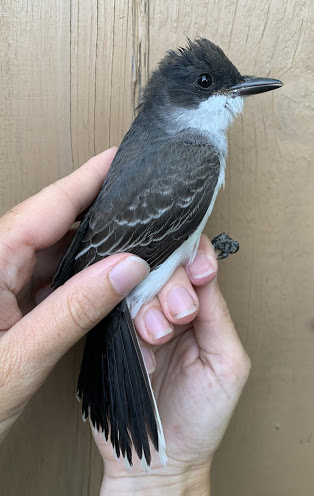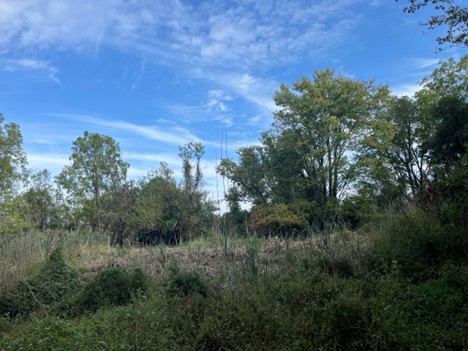In 2018, New Jersey Audubon’s Cape May Bird Observatory and NJA’s Research Department launched the Cape May Songbird Stopover Project (CMSSP, formerly known as the Cape May Songbird Banding project) in partnership with Cellular Tracking Technologies and The Nature Conservancy. Our overarching goal for the project is to develop tools and information that ensures the conservation of migratory landbirds on the Cape May Peninsula. Our primary objectives are:
- Determine the physiological condition of birds during stopovers on the Cape May Peninsula
- Quantify stopover duration of migrating individuals
- Improve understanding of habitat use in migratory birds on the Cape May Peninsula and evaluate whether stopover duration predicts habitat quality through condition scores of migrants or how this varies by age or sex
- Identify shifts in migration phenology (e.g., earlier arrivals, later departures, changes in stopover durations) through standardized banding operations across multiple seasons
- Develop population trend indices for target species
This August, the project was slated to start its third year but with a significant impediment – COVID-19. In fact, the possibility of even conducting the project in 2020 was in jeopardy because of the pandemic. However, we were able to integrate COVID-19 safety protocols (masks, distancing, hand-washing) developed for other field projects we conducted since March, like the DE Bay Shorebird Stopover Project and the Powerline Right-of-Way Project.
Importantly, we were able to hire three highly qualified staff to work on the project, who had to quarantine in New Jersey once they arrived in early August. One of the big challenges was housing, as the site we normally use for many of our fall seasonal staff was not available because of COVID. The staff decided to rent a house together, believing that this would help form an insulated “COVID-proof family.” So far, it has been a highly effective strategy. Here a brief introduction to this year’s team:
Lauren diBiccari (Bander-in-charge): Lauren is a North America Banding Council Certified Trainer that has worked as a passerine and raptor bander throughout North and Central America for the past six years. She most recently managed the long term monitoring banding and bander training program at Klamath Bird Observatory (KBO) in Southern Oregon. She loves reading the clues in molt and plumage details, eye color, bill striations, mouth linings and gapes, and windows in skulls to elucidate the story of the individual bird and their populations.
(David) Julian Tattoni (Bander-in-charge): Julian was a bander for three years at the San Francisco Bay Bird Observatory’s Coyote Creek Field Station, one of the oldest year-round banding stations in North America. He/They works at the intersection of field and quantitative avian ecology by using banding datasets to understand the varied response of birds to global change.
Elsa Chen (Banding Assistant): Elsa recently graduated from Virginia Commonwealth University with a Master of Science degree in Biology, where she focused on female aggression in the Prothonotary Warbler. She has banded birds during the spring and fall migration seasons at Manomet in Massachusetts and has also worked on projects focused on Bachman’s Sparrows in North Carolina and Cerulean Warblers in Indiana.
As we have in prior years, we kicked off the season on August 15th at The Nature Conservancy’s South Cape May Meadows Preserve. During the first few days, we captured a variety of local breeder, including a pair of Carolina Chickadees. These birds were caught as juveniles, or hatching-years (HYs) on the same day last year and were caught together in the same net this year. Friends forever!
Large flocks of swallows migrate through Cape May each fall and we’ve already been seeing flocks of several hundred passing through the banding site. So far, we’ve caught both a Tree Swallow and a Rough-winged Swallow — both firsts for the station! We’ve also caught 2 other species not previously encountered at our station: a Black-billed Cuckoo and several Orchard Orioles.
Although typical summer weather conditions in Cape May (heat and high winds) prevented us from operating the banding station on many days for the standard six hours, we captured and banded more than 800 birds of 46 species during this season’s first three weeks. NW winds on the night of August 25 produced a large fallout of migrants on August 26, which resulted in our biggest day for August since the project started – 173 birds. The majority of these were American Redstarts, but we also had good numbers of Northern Waterthrush, Common Yellowthroat and “Traill’s” Flycatcher (Alder/Willow). The day also included our first of season Cape May and Magnolia Warblers.
Cape May is well known for the thousands of swallows that migrate through each fall and we’ve already seen flocks of several hundred passing over the Meadows. So far, we’ve caught a Tree Swallow and a Northern Rough-winged Swallow – both firsts for the project! We also caught two other species not caught during our previous two seasons: a Black-billed Cuckoo and several Orchard Orioles. Although not a first for the station, we also caught 13 Eastern Kingbirds (all HYs) since we started the season, which is considerably more than the five we caught in 2018 and 2019 combined. It was great to get closer looks at this large flycatcher!
The first three weeks have been exciting, but we’re looking forward to cooler days and what else fall migration will bring our way!
The CMSSP Team
SPECIES TOTALS: All birds captured through 9/3/2020. Species new for the project are noted with an asterisk (*).


















